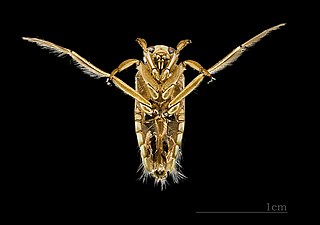
Notonectidae is a cosmopolitan family of aquatic insects in the order Hemiptera, commonly called backswimmers because they swim "upside down" (inverted). They are all predators and typically range from 0.5 to 1.5 cm (0.2–0.6 in) in length. They are similar in appearance to Corixidae, but can be separated by differences in their dorsal-ventral coloration, front legs, and predatory behavior. Their dorsum is convex, lightly colored without cross striations. Their front tarsi are not scoop-shaped and their hind legs are fringed for swimming. There are about 350 species in two subfamilies: Notonectinae with seven genera, and Anisopinae with four genera. Members in the former subfamily are often larger than those in the latter.

The Anthomyiidae are a large and diverse family of Muscoidea flies. Most look rather like small houseflies. Most species are drab grey to black. Many Pegomya are yellow, and some members of the genera Anthomyia and Eutrichota are patterned in black-and-white or black-and-silvery-grey. Most are difficult to identify, apart from a few groups such as the kelp flies that are conspicuous on beaches.

Sarcophaga is a genus of true flies and the type genus of the flesh-fly family (Sarcophagidae). The members of this cosmopolitan genus are frequently known as common flesh flies.

Fannia is a very large genus of approximately 288 species of flies. The genus was originally described by the French entomologist Jean-Baptiste Robineau-Desvoidy in 1830. A number of species were formerly placed in the genus Musca.
Euryomma is a genus of species of flies of the family Fanniidae. The genus was originally proposed by the entomologist Paul Stein in 1899. Although at that time most authorities placed them in the family Muscidae. The distribution of Euryomma is mainly Neotropical, on the whole restricted to the Americas, there is also one Nearctic species, the exception being of the very cosmopolitan E. peregrinum
Hygiella is a genus of flies in the family Tachinidae. The genus was originally placed in the tribe Blondeliini; however, Shima and Tachi (2016) assigned it to the tribe Acemyini.

Hybotinae is a globally widespread subfamily of hybotid flies.
This list of fossil arthropods described in 2012 is a list of new taxa of trilobites, fossil insects, crustaceans, arachnids and other fossil arthropods of every kind that have been described during the year 2012. The list only includes taxa at the level of genus or species.

Rhabdotis albinigra is a species of Scarabaeidae, the dung beetle family. It was described by Hermann Burmeister in 1847.

Haplothrips is a genus of thrips in the family Phlaeothripidae. It is found worldwide and contains about 240 extant species.
Malo filipina is a small and venomous Irukandji jellyfish found in the Philippines. It was first described to science in 2012, and is one of four species in genus Malo, often confused in the past with the M. maxima.
Brachygasterina muisca is a species of fly in the genus Brachygasterina of the subfamily Muscinae, described in 2012 by Soares and De Carvalho.
Somatia is the sole genus of the acalyptrate brachyceran fly family Somatiidae. The genus includes about seven Neotropical species of small black and yellow flies with a stout and rounded thorax having transverse suture. The legs are separated from the main body by an elongated post-coxal bridge. The broad abdomen is downcurved. The antenna are elbowed with the arista bipectinate. Somatiids resemble members of the Syringogastridae due to the enlarged pronotum and a postcoxal bridge but they have a petiolate abdomen.
2015 in paleoentomology is a list of new fossil insect taxa that were described during the year 2016, as well as other significant discoveries and events related to paleoentomology that were scheduled to occur during the year.

Mesembrinellidae is a family of Neotropical flies in the order Diptera, and formerly included in the Calliphoridae. There are 36 described species.

Mesembrinella is a genus of Neotropical flies in the family Mesembrinellidae, and formerly placed in the Calliphoridae.

Mesembrinellinae is a subfamily of Neotropical flies in the order Diptera, and formerly included in the Calliphoridae. There are 33 described living species.
Laneellinae is a subfamily of Neotropical flies in the family Mesembrinellidae, and formerly placed in the Calliphoridae.
This paleoentomology list records new fossil insect taxa that were described during the year 2014, as well as notes other significant paleoentomology discoveries and events which occurred during that year.







